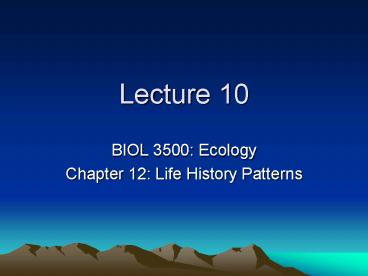BIOL 3500: Ecology - PowerPoint PPT Presentation
1 / 26
Title:
BIOL 3500: Ecology
Description:
Male and female parts are on different plants. Pine Trees ... Male-male combat in bighorn sheep. Combat among male sea elephants. Intersexual selection ... – PowerPoint PPT presentation
Number of Views:48
Avg rating:3.0/5.0
Title: BIOL 3500: Ecology
1
Lecture 10
- BIOL 3500 Ecology
- Chapter 12 Life History Patterns
2
Learning Objectives
- Contrast
- Monoecious vs. dioecious plants
- Monogamy vs. Polygamy
- Polygyny vs. polyandry
- Semelparity vs. iteroparity
- R vs. K selected species
- Define
- Clutch
3
Moneocious Plants
- Greek for one house
- Both male and female reproductive parts on one
plant - Botany Question
- Which of these has a
- perfect flower?
- Imperfect?
4
Dioecious Plants
- Greek for two houses
- Male and female parts are on different plants
5
Pine Trees
- Which reproductive pattern would pine trees fall
into?
6
Mating Systems
- Involve the number of mates, nature of bond,
pattern of parental care - Monogamy
- Polygamy
- Polygyny
- Polyandry
7
Monogamy
- Unique pair bond formed by one female and one
male - Good mating system if raising offspring requires
cooperation, or if male and female equally able
to contribute - Common among birds (90 of species)
- Rare among mammals (but some exist, like foxes,
wolves, mustelids) - Both parents can bring meat
8
A Variation
- Monogamy w/ extra-pair copulations
- Advantage extra genetic variability among
offspring - Can still maintain strong partnership to rear
offspring
9
Polygamy
- Acquiring two or more mates
- Polyandry one female, many males
- Polygyny one male, many females
10
Sexual Selection
- Process of choosing a mate (generally females
choose males) - Idea is to pick mate w/ best genes
- Bowerbirds are a great example
- PBS website (check NOVA News Minute)
- Bird Families of the World website
11
Runaway Selection
- Females look at trait for judging male fitness
- Males evolve to enhance that trait
- Survival of males decreases because of trait
- Irish elk
- UC Berkeley website
- Discovery Channel website
- BBC website
12
Handicap Hypothesis
- Put forward by A. Zahavi (1975, 1977)
- Still very controversial
- 3 elements
- A handicap which decreases males survival
- Bright plumage
- Viability trait which affects males ability to
survive - Escape from predators
- Female mating preference for handicap
- Peacocks?
13
Different Kinds of Sexual Selection
- Intrasexual selection
- Occurs when competing/fighting against ones own
sex is important - Male-male combat in bighorn sheep
- Combat among male sea elephants
- Intersexual selection
- When convincing a mate is more important
- Competing male bowerbirds building big houses
14
7th Inning Stretch
15
Iteroparous Organisms
- Can potentially breed repeatedly over lifetime
- Examples
- Humans
- Rats
- Oak trees
- Sequoias
16
Semelparous Organisms
- Reproduce once, then die
- Pacific salmon
- Overlapping generations Reproduce _at_ 2, 3, 4, or
5 years old - Some bamboos
- Reproduce asexually most of time
- Produce flowers once every 100 years!
17
Adjusting Reproduction
- Organisms have a variety of ways to adjust
reproduction for maximum fitness - Options exist for
- Kinds of offspring (babies either altricial vs.
precocial) - Size of offspring (seeds in plants)
- Number of offspring
18
Altricial offspring
- Small, helpless
- Rodents born blind
- Robins need food from parents
- Parental investment is generally smaller
- Shorter gestation time
- Smaller eggs (although parents must feed later)
19
Precocial offspring
- Young can care for themselves
- Whales can swim
- Baby elephants can walk
- Chickens, quail feed themselves
- Parental investment is generally large
- Long, long gestation times!
20
Trade-offs and Environment
- Some species (like goldenrod) have phenotypic
plasticity - In competitive environment, large seeds favored
- In uncolonized (or disturbed) environment, many
seeds are favored
21
Body Size and Fecundity
- Among many mammals, number offspring depends upon
body size - European red squirrelss fecundity depends upon
body weight at first winter as adults - Irrespective of habitat type
22
Clutch Size and Environment
- Clutch bunch of eggs
- Clutch size ( of eggs) is variable among similar
bird species - Icteriadae blackbirds, orioles, meadowlarks
- Oxyura ruddy ducks and masked ducks
- More food available for babies (temperate vs.
tropical) more eggs. Why is more available?
23
R vs. K selected Species
- MacArthur Wilson (1967)
- Emphasized trade-off between many life history
traits - Number of offspring
- Lifespan
- Survivorship
- Parental investment
24
r selected species
- Species which reproduce quickly
- Many offspring
- Short-lived
- Low parental investment
- Have Type III survivorship curve
- Ex rats, oysters, dandelions
25
K selected species
- Species which reproduce slowly
- Few offspring
- Longer-lived
- High parental investment
- Have Type I survivorship curve
- Ex polar bears, trees
26
Grimes Triangle
- 3-strategy alternative to Mac Ws paradigm
- C competition
- S stress
- R ruderal (disturbance)































